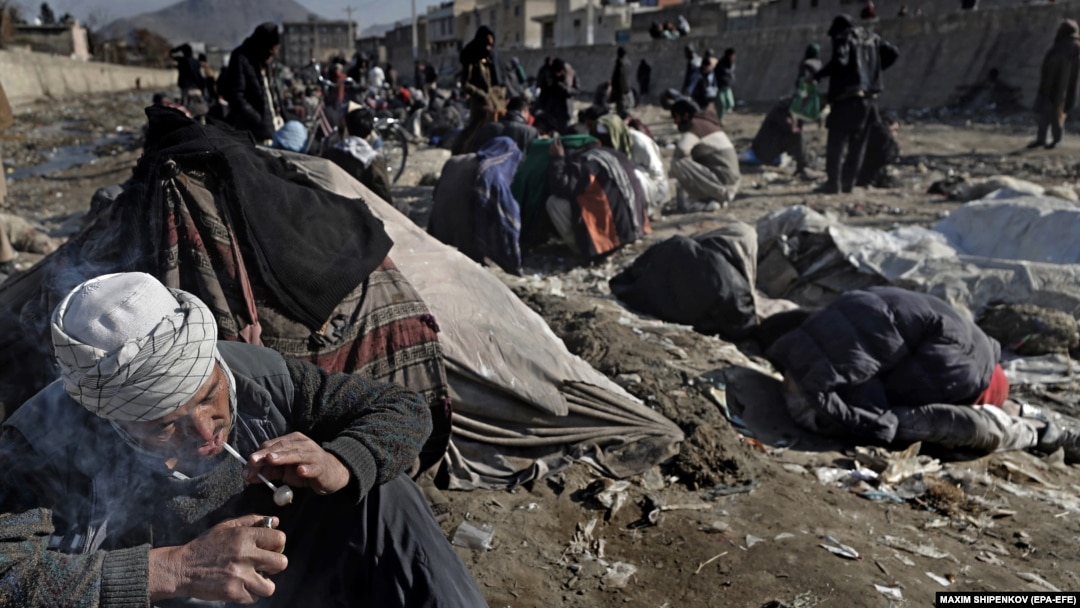A devastating humanitarian and economic crisis has forced millions of Afghans to find new sources of income.
A growing number of them have turned to the booming methamphetamine industry to eke out a living and stave off starvation.
Among them is Ahmad Wali, who lives in the remote province of Ghor in central Afghanistan. Wali is believed to be among the thousands of people who earn money by collecting ephedra, a wild herb that is used to make crystal meth.
"For now, it is our only source of income," he told RFE/RL's Radio Azadi. "We collect it from the mountains and sell it in the city."
The Taliban's takeover of Afghanistan in August 2021 worsened a major humanitarian crisis and triggered an economic collapse. Western donors abruptly cut off assistance to the heavily aid-dependent country and imposed sanctions on the new, unrecognized government.
An estimated 1 million Afghans have lost their jobs since the militant group seized power, joining the hundreds of thousands who were already unemployed.
WATCH: After 30 years in business, Gul Rahman says he may have to close his Kabul butcher's shop as the demand for meat collapses.
Your browser doesn’t support HTML5
No Money, No Meat: A Kabul Butcher Feels Afghan Economic Collapse
'Safety Net'
Harvesters sell ephedra, a common herb that is locally known as "oman," in local markets for around $5 per kilogram. The buyers, most of them middlemen, then sell it on for a profit.
"I profit by buying it from the harvesters and selling it on to major [producers]," Noor Ahmad, a distributor from Ghor, told Radio Azadi.
An ephedra plant
The ephedra is then processed in the hundreds of meth labs that are believed to exist in Afghanistan to make meth. The drug, which has the appearance of white crystals, is then smuggled to neighboring countries, from where it eventually reaches Europe and North America.
The crystal-meth industry took off around 2017, when drug traffickers discovered that the native ephedra herb could be used to make ephedrine, the key ingredient in crystal meth.
For decades, Afghanistan has been the world's biggest producer of opium. But experts say the country has also become a significant supplier of crystal meth.
The meth industry is booming despite the Taliban issuing a ban in December 2021 on the cultivation, production, and trafficking of all illicit narcotics.
Experts say the militant group has turned a blind eye to the lucrative drug trade. The cash-strapped Taliban government, they say, is unwilling to enforce its ban because illicit narcotics remains a major source of revenue.
SEE ALSO: Taliban Turns Blind Eye To Opium Production, Despite Official BanThe militants are also unable to provide alternative livelihoods for the tens of thousands of farmers who are dependent on the drug trade for survival, experts say.
"The narcotics industry and other informal aspects of the economy appear to be serving as a safety net for the vast numbers of Afghans thrust into poverty since the Taliban takeover," Graeme Smith, an author on Afghanistan and a senior consultant for the International Crisis Group, a Brussels-based think tank, told RFE/RL.
Wahid Hamas, the spokesman for the Taliban's governor of Ghor Province, said the authorities were serious about rooting out drugs in Afghanistan, which is home to an estimated 3.5 million addicts, a number that accounts for around 10 percent of the population.
Hamas said the group had seized tons of narcotics, arrested dozens of alleged traffickers, and destroyed drug labs since the ban was issued.
"That would mean depriving hungry people of livelihoods at the same time as foreign donors give less and less assistance," Smith pointed out. "This double whammy could immiserate even more Afghans."
International donors provided around $3 billion in humanitarian aid to Afghanistan in 2022, a figure that Smith says is unlikely to be matched this year.
'Staggering' Production
For years, the Taliban has taxed poppy farmers and been involved in the trafficking of narcotics to neighboring countries.
The United Nations estimated that the Afghan opium trade generated some $2.7 billion of income in 2021. A 2020 report commissioned by NATO said that the Taliban earned more than $400 million from the drug industry, although some experts believe such estimates are exaggerated.
SEE ALSO: Exclusive: Taliban's Expanding 'Financial Power' Could Make It 'Impervious' To Pressure, Confidential Report WarnsNajib Ahmadi, a former senior Afghan counternarcotics official, says that during its insurgency the Taliban was against the production of meth and banned it in areas it controlled. The group, he says, feared that meth would undermine its income from taxing opium cultivation and heroin trafficking.
"[But] the production of meth has increased after the Taliban returned to power," he said. "Meth is now being processed in all corners of the country."
Ahmadi adds that most of the meth in Afghanistan was produced in the country's western and northern provinces.
"The production of meth has been staggering since the Taliban captured power," he said. "It now competes with opiates."


